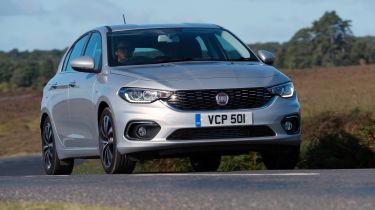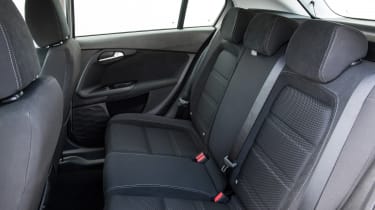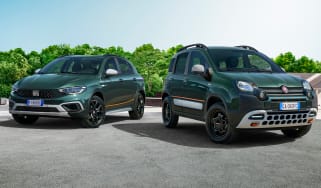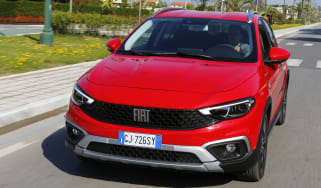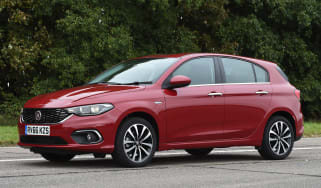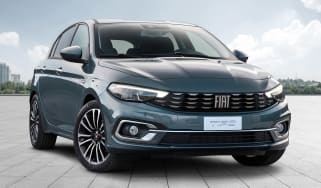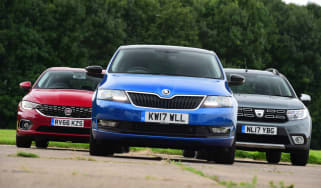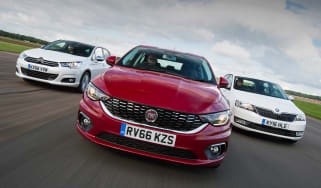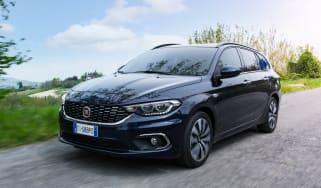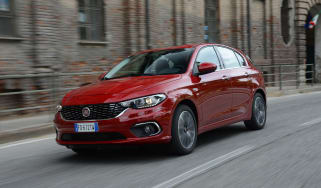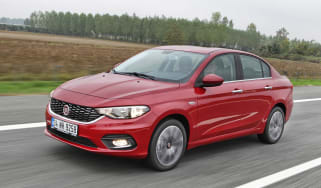Fiat Tipo (2016-2023) review
The Fiat Tipo comes as a compact hatch or SW estate, and it's easy to drive, offers decent space and is good value for money

This is a review of a new 2016-2023 Fiat Tipo. If you are interested in information about a used Fiat Tipo please follow the links provided.
The Fiat Tipo is a well-rounded budget hatch. It offers more than enough practicality for most situations, while the strong engine and comfortable chassis make it an acceptable family five-door to live with. However, it’s the Fiat’s thrifty running costs that seal the deal.
While the entry-level Tipo is especially cheap in Europe, the higher UK pricing invites comparison with some much more accomplished rivals. The Vauxhall Astra, for example, is much more fun to drive without sacrificing economy or comfort - and that’s where the Tipo loses out most.
While many Italian cars have character that helps gloss over their shortcomings in some areas, the Tipo's dull driving experience is likely to put some people off. The styling details are neat, but the overall shape of the Tipo, along with its interior, is disappointingly drab. If you’re looking for a cheap family car, certainly give the Tipo a look.
The Fiat Tipo and Fiat Tipo Station Wagon (SW) estate are compact family cars, but they're for sale at a lower price than rivals such as the Ford Focus and VW Golf, so theoretically offer better value for money. There's also the saloon version to consider, although it's only offered with a 94bhp petrol engine.
Used - available now

2023 Audi
A3 Sportback
18,214 milesAutomaticDiesel2.0L
Cash £25,049
2019 Vauxhall
Corsa
31,799 milesManualPetrol1.4L
Cash £8,999
2023 Vauxhall
Corsa
11,623 milesAutomaticPetrol1.2L
Cash £15,499
2022 Volkswagen
T-Roc
12,422 milesAutomaticPetrol1.5L
Cash £22,099Fiat has used existing tech for the Tipo. It's built on an enlarged platform that's shared with the likes of the Jeep Renegade, Fiat 500L or 500X and Fiat Doblo van, while engines and in-car technology are also common with other Fiat, Alfa Romeo and Jeep vehicles.
Those engines include Fiat's ageing naturally aspirated 1.4 petrol, the newer 1.4 T-Jet turbo petrol and 1.6 Multijet diesel. All cars are front engine, front-wheel drive, with 6-speed manual gearboxes for the petrol engines and an optional 6-speed auto for the diesel.
The Tipo range is structured in a simple way, with straightforward price rises between grades. The entry-level 1.4 95hp Easy hatchback starts at around £15,000, while Higher spec Lounge trim is £2,000 more than Easy. Sporty S-Design is another £1,000 on top of that, with the top-of-the-range Sport versions costing just over £21,000.
The 1.6-litre diesel is only available in Mirror and Lounge trim. Choose S-Design, and you only have the petrol engines to choose from. Any of these trims can be had in Tipo SW estate guise. And guess what? £1,000 is added to the list price.
As well as this core model range, Fiat offers plenty of good-value special editions with added kit. The Fiat Tipo Street is an upgrade of Easy trim for £500 that adds black detailing, black alloy wheels and tinted windows for a sportier look, but retaining the pedestrian 1.4-litre petrol engine. Elsewhere, the Fiat Tipo Mirror adds touchscreen infotainment with Apple CarPlay and Android Auto, plus other kit for a modest price increase over Easy Plus.
Another special is the Fiat Tipo Sport. This takes S-Design and adds a sportier bodykit with a rear diffuser, front splitter, side skirts and a black contrast roof. There's more kit inside, too, although again it only comes with the two petrol engine options, so there's no power upgrade to go with the sportier looks.
Overall, the Fiat Tipo is a decent budget choice, and offers more kit than similarly priced versions of cars such as the Focus, Renault Megane and Peugeot 308. But it does feel like a budget option inside, and the dated technology under the skin means it's not as dynamic as its rivals and is likely to be pricier to run, too.
Engines, performance and drive
On the move, the Fiat Tipo has a relaxed feel, with soft suspension and a comfortable driving position adding up to a smooth driving experience.
As a result of that comfort-focused softness, the Fiat loses out when it comes to the driving experience. The car rolls quite a bit as you take a turn quickly, and while the steering doesn’t have a lot of feel, it’s weighted well enough, and there’s plenty of grip. It’s not a bad car to drive, but the Vauxhall Astra and Ford Focus put it to shame, unfortunately. The Astra is just as comfortable to drive, too.
While the Tipo is a little behind its rivals for ride comfort, for example, there’s really not much in it and the Fiat does tackle bumpy roads pretty well, as well as keeping small imperfections in the background. The seating position feels lower than in rivals, although it's no more comfortable.
Engines
The naturally aspirated 94bhp 1.4 petrol is very refined, being very quiet at low revs around town and only making an intrusive noise at higher speeds. Wind and road noise start to build up as well on the motorway - though those are generally well contained in the Tipo. Performance from the petrol unit isn’t bad, but it’s not as punchy as the turbo petrol or diesel.
While the 1.4 T-Jet is slightly thirstier, we'd choose this engine over the other petrol because of its better responses. There's more torque from lower revs, and with 118bhp on tap it's sprightly enough to keep pace with traffic.
The 1.6-litre diesel is rattly from the outside, but it’s nearly as quiet as the petrol from the inside. Rev it hard and you’ll certainly hear the harsh noise, but most of the time the engine note is very much in the background. With 320Nm of torque, the diesel feels rapid, especially in-gear. The engine feels gutsy when the turbo kicks in, delivering plenty of torque to push the car along – which is a good thing, as it means you don’t have to rev it too hard. The six-speed manual feels rubbery, and if you change gears too fast, it’ll crunch as you slot the next ratio home.
There’s plenty of torque at low revs, which makes motorway driving easier since you won’t have to change down to start an overtake. Plus, it means you can stay away from the top the rev range, which is a lot noisier – sadly, the Tipo suffers in terms of refinement, with the Multijet engine being rattly and sounding unpleasant in the cabin.
MPG, CO2 and Running Costs
The Tipo was designed from the start to be a good value car, and its low price in mainland Europe reflects that - but in the UK it’s more expensive and that invites comparison with some much more accomplished models.
Even the top-spec Tipo isn't too much money, and if you’re looking for a spacious hatch on a shoestring, the range starts from about £15,000, while Fiat's finance deals are tempting. This will get you a 94bhp 1.4 petrol in Easy trim, but with all models receiving DAB, Bluetooth and air-con, the kit offered on even the most basic Tipo is respectable. If you need even more space, the Tipo Station Wagon boasts a 550-litre boot, and costs an extra £1,000. The saloon version is only offered with the old 94bhp 1.4-litre petrol engine and is priced at just over £14,000 in Easy trim, with an additional £500 getting you into a Street spec model.
However if you want decent equipment and an economical engine in your Fiat Tipo you’ll need to spend a bit more, and at that point you are well into the price range of a more traditional hatchback rival like the Vauxhall Astra.
The entry-level engine is the 94bhp 1.4 petrol, which has been tested on the latest WLTP test cycle and returns up to 40.7mpg. This figure is poorer in higher spec cars that are heavier and come with larger wheels and tyres, but only by a couple of MPG in comparison. The more powerful 118bhp 1.4 T-Jet turbo petrol offers better performance, but without much penalty in terms of economy. In Mirror trim, the 1.4 has quoted economy of up to 37.2mpg, but the T-Jet is quoted at up to 36.7mpg, only half a mile per gallon poorer.
The Multijet diesel is a 1.6-litre engine with the same 118bhp output as the T-Jet petrol. It offers good low-end torque and returns up to 51.4mpg on the WLTP test cycle.
Emissions are as low as 110g/km for the diesel Tipo, while the petrol cars return 149g/km for the 1.4 and 153g/km for the T-Jet motor.
Insurance
As it's supposed to be a budget compact hatch, you'd expect low insurance ratings. And that's what you get, with all cars in the Tipo range falling into Group 6. In comparison, the Vauxhall Astra starts in Group 10.
Depreciation
Fiat Tipo buyers will take a hammering when it comes to depreciation. The car's budget roots, mainstream badge and relatively low-tech build and technology mean the range sees depreciation go no higher than 31 per cent after three years/36,000 miles. That's among the poorest residuals in the new car market, let alone the compact hatchback class.
To get an accurate valuation on a specific model check out our free car valuation tool...
Interior, design and technology
The Fiat Tipo focuses on price, but it hasn’t cut corners with its styling. Taking design cues from the brand’s flagship 124 Spider roadster, the car gets a wide grille, chrome details and double-bubble roofline that all give the hatchback presence on the road.
There are more vents underneath with chrome scoops to reinforce the sportier look on Lounge trim cars, but the slats in the lower grilles don’t feature the glossier silver inserts used in the main radiator inlet. Plenty of flowing lines give the car a sharp look, and the raked windscreen means it appears sportier than many practicality-focused five-doors, too.
It’s easy to see where the Tipo’s versatility comes from, as the upright tailgate helps to maximise boot space, given the car’s relatively compact overall proportions. The design isn’t quite as taut at the rear, but the boot-lip spoiler balances the lower front bumper and 17-inch two-tone alloy wheels that comes as standard on our test model. The range of colours isn’t great, and aside from silver, a dull red is the brightest hue among plenty of greys plus brown and dark blue.
There are two body styles, and the SW estate’s design is very similar to the hatch, but with the obvious extended roofline to make the boot bigger. It adds headroom in the back seats, too.
At this price, and with the Fiat’s relatively attractive exterior design, there’s a risk that pennies could have been pinched inside, but the Tipo’s cabin just about stands up to scrutiny, and the quality of the materials is only really acceptable at best, as harder plastics still dominate most areas.
There’s lots of different textures to contend with, too, as the softer plastic that covers the dash clashes with the material around the air vents, centre console and trim inlays.
However, the Alfa Romeo-sourced climate controls are a neat touch, while the ergonomics are pretty good, too. But the unusual grain Fiat has used on the dash and doors doesn’t exactly have a premium feel.
Sat-nav, stereo and infotainment
A TomTom-based sat-nav system is fitted in the Fiat. It’s clear and has live traffic updates, but the screen is on the small side, so it’s not as easy to see any detail as it is in rivals. The standard reversing camera is a nice touch, and it’s good enough for parking with, while the buttons around the unit mean it’s easy to use when you’re driving.
While the screen is more responsive than the unit you'd find in a Dacia Logan, it is not what you would call swift or intuitive. The user interface isn’t that bright but it does at least seem to have a colour scheme, unlike the garish Dacia system.
Practicality, comfort and boot space
The Fiat Tipo’s real strong point is its practicality. In fact if you need a practical family car for supermini money, the Tipo could be a great choice in lower specifications. It’s available as a hatch, SW estate or saloon and you get a lot of space, no matter which you choose.
The driving position is good, and visibility is as good as any of its rivals. There’s a good amount of space around the cabin for your family’s bits and bobs, totalling 12 litres. There’s a USB port for charging phones and other electronic devices, too.
Dimensions and size
The Fiat Tipo is 4.37m long, 1.79m wide and 1.5m tall, making it one of the largest cars available at a similar entry-level price. The Station Wagon estate is 20cm longer, at 4.57m long, and that means you can fit objects up to 1.8m long in the back with the seats folded down. It doesn’t feel too big on the road, however, and is still easy enough to drive around town and park.
Leg room, head room & passenger space
There’s plenty of leg and head room in the front and back seats, although in the hatchback version rear seat passengers who are particularly tall might find their head brushing the roof.
The back seats are fairly comfortable too, and while the middle seat isn't the most comfortable place for adults, it’s good enough for shorter trips. It’s certainly much more roomy than similarly-priced rivals in the segment below, though it’s not hugely bigger than other family hatchbacks like the Vauxhall Astra. The doors open nice and wide, which should be useful for fitting child seats.
It lives up to its practical billing with decent storage, thanks to a deep tray in front of the gearlever and a pair of cup-holders behind. There’s also a central armrest between the front seats that reveals another cubby when lifted, although there’s less practical storage for rear passengers.
Boot space
For a compact five-door hatch, the Tipo’s 440-litre boot should be more than enough to carry day-to-day luggage; it can swallow a family of four’s belongings. The estate gets 110 litres more, with a 550 litres available with the seats up. You can fold the 60/40 split seats down and the seat bases also fold so you can get the backs fully down, for a flat load floor.
The hatch doesn’t have any extra storage options in the back but the estate has a removable floor with some extra pockets at the side. There are two bag hooks and four load-retaining brackets back there, too.
Reliability and Safety
The Fiat Tipo was given a four-star Euro NCAP rating for the car’s safety when it was tested in 2016, but that was only with the optional Safety Pack added. However, the car's percentage scores are reasonable.
As the Tipo sells in relatively low numbers, it doesn't tend to appear in our Driver Power survey. Fiat finished a credible 15th out of 30 manufacturers in 2019, with reliability - an historical Fiat bugbear - now being one of the higher rated aspects of Fiat ownership. What lets the side down are the company's below-par infotainment systems and limited storage on board - although that's unlikely to be an issue with the Tipo.
Warranty
The Fiat Tipo comes with an industry-standard three-year new car warranty, which is on a par with its rivals. That means any issues that crop up in the important first part of ownership will be covered, although be aware that the first two years are manufacturer-covered and the final year will be dealer-covered, with a mileage limit of up to 60,000 miles.
Usefully, the warranty comes with breakdown cover for the same amount of time - not that we're saying that you're going to need it if you buy a Tipo, as Fiat's reputation for reliability has improved in recent years.
Servicing
Fiat's aftersales service is provided by its Mopar sub division. Buy a Tipo, and Fiat offers some attractive maintenance packages at very reasonable prices. For example, you can get a standard Easy Care servicing package for around £400 normally, but Fiat will half the cost if you take the service package when you buy your car.
Fiat Tipo history
The Fiat Tipo hatchback introduced in the UK in 2016 (it arrived first as a saloon in other markets in 2015) is the second car to use the Tipo name. The original Tipo of 1988 was the successor to the Ritmo, and it even won the European Car Of The Year title in 1989. You'll be hard-pressed to find one these days, but its platform was used on a number of other cars, including the Alfa Romeo 145/146, Fiat Coupe Turbo and Lancia Delta.
While that car also spawned the Fiat Tipo 16V hot hatchback, that hasn't been the case with the current car. The only real variation is the Tipo Station Wagon estate, which offers added practicality over the hatch courtesy of its larger boot.

